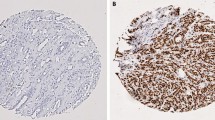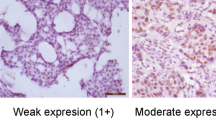Abstract
Purpose Abnormal expression of the cell cycle regulatory protein Bmi-1 has been studied in breast cancer, but the clinical relevance has not been fully elucidated. We studied the expression of Bmi-1 protein in breast cancer patients to define its clinical significance in breast cancer. Experimental Design Tissue microarrays were performed to evaluate the expression of Bmi-1 by immunohistochemistry in tumor tissues from 960 patients with stage I–III breast cancer. We assessed the relationship between the expression of Bmi-1 and pathologic prognostic indices as well as clinical long-term follow up outcome. Results Bmi-1 was expressed in 53.2% of breast cancer patients by immunohistochemistry, and the expression of Bmi-1 was significantly correlated with favorable prognostic indices at diagnosis. In univariate analysis, patients with Bmi-1 expression showed favorable relapse-free survival (88.6 ± 2.7% vs. 72.3 ± 4.3%, P = 0.041) and favorable overall survival (93.5 ± 2.2% vs. 82.6 ± 3.5%, P < 0.001) than patients without Bmi-1 expression. According to multivariate analyses, Bmi-1 expression was identified as independent prognostic factor for overall survival with a statistical significance (hazard ratio of Bmi-1 (−) patients compared to Bmi-1 (+) patients, 1.744; 95% CI, 1.013–3.003; P = 0.045). This correlation of Bmi-1 expression with favorable overall survival was maintained in patients underwent uniform chemotherapy, regardless of undergoing adjuvant chemotherapy. In a subset analysis according to ER status, Bmi-1 expression associated with favorable overall survival only in ER-positive patients. Conclusions Bmi-1 expression assessed with Immunohistochemistry may be associated with favorable overall survival in breast cancer patients, especially in patients with ER-positive breast cancer.




Similar content being viewed by others
References
Clurman BE, Roberts JM (1995) Cell cycle and cancer. J Natl Cancer Inst 87:1499–1501
Porter PL, Barlow WE, Yeh IT et al (2006) p27(Kip1) and cyclin E expression and breast cancer survival after treatment with adjuvant chemotherapy. J Natl Cancer Inst 98:1723–1731
Keyomarsi K, Tucker SL, Buchholz TA et al (2002) Cyclin E and survival in patients with breast cancer. N Engl J Med 347:1566–1575
Alkema MJ, Wiegant J, Raap AK et al (1993) Characterization and chromosomal localization of the human proto-oncogene BMI-1. Hum Mol Genet 2:1597–1603
Liu S, Dontu G, Wicha MS (2005) Mammary stem cells, self-renewal pathways, and carcinogenesis. Breast Cancer Res 7:86–95
van Lohuizen M, Verbeek S, Scheijen B et al (1991) Identification of cooperating oncogenes in E mu-myc transgenic mice by provirus tagging. Cell 65:737–752
Sawa M, Yamamoto K, Yokozawa T et al (2005) BMI-1 is highly expressed in M0-subtype acute myeloid leukemia. Int J Hematol 82:42–47
Mihara K, Chowdhury M, Nakaju N et al (2006) Bmi-1 is useful as a novel molecular marker for predicting progression of myelodysplastic syndrome and patient prognosis. Blood 107:305–308
Vonlanthen S, Heighway J, Altermatt HJ et al (2001) The bmi-1 oncoprotein is differentially expressed in non-small cell lung cancer and correlates with INK4A-ARF locus expression. Br J Cancer 84:1372–1376
Jacobs JJ, Scheijen B, Voncken JW et al (1999) Bmi-1 collaborates with c-Myc in tumorigenesis by inhibiting c-Myc-induced apoptosis via INK4a/ARF. Genes Dev 13:2678–2690
Jacobs JJ, Kieboom K, Marino S et al (1999) The oncogene and Polycomb-group gene bmi-1 regulates cell proliferation and senescence through the ink4a locus. Nature 397:164–168
Smith KS, Chanda SK, Lingbeek M et al (2003) Bmi-1 regulation of INK4A-ARF is a downstream requirement for transformation of hematopoietic progenitors by E2a-Pbx1. Mol Cell 12:393–400
Liu S, Dontu G, Mantle ID et al (2006) Hedgehog signaling and Bmi-1 regulate self-renewal of normal and malignant human mammary stem cells. Cancer Res 66:6063–6071
Breuer RH, Snijders PJ, Sutedja GT et al (2005) Expression of the p16(INK4a) gene product, methylation of the p16(INK4a) promoter region and expression of the polycomb-group gene BMI-1 in squamous cell lung carcinoma and premalignant endobronchial lesions. Lung Cancer 48:299–306
Bea S, Tort F, Pinyol M et al (2001) BMI-1 gene amplification and overexpression in hematological malignancies occur mainly in mantle cell lymphomas. Cancer Res 61:2409–2412
Kim JH, Yoon SY, Kim CN et al (2004) The Bmi-1 oncoprotein is overexpressed in human colorectal cancer and correlates with the reduced p16INK4a/p14ARF proteins. Cancer Lett 203:217–224
Song LB, Zeng MS, Liao WT et al (2006) Bmi-1 is a novel molecular marker of nasopharyngeal carcinoma progression and immortalizes primary human nasopharyngeal epithelial cells. Cancer Res 66:6225–6232
Dimri GP, Martinez JL, Jacobs JJ et al (2002) The Bmi-1 oncogene induces telomerase activity and immortalizes human mammary epithelial cells. Cancer Res 62:4736–4745
Raaphorst FM, Meijer CJ, Fieret E et al (2003) Poorly differentiated breast carcinoma is associated with increased expression of the human polycomb group EZH2 gene. Neoplasia 5:481–488
Kim JH, Yoon SY, Jeong SH et al (2004) Overexpression of Bmi-1 oncoprotein correlates with axillary lymph node metastases in invasive ductal breast cancer. Breast 13:383–388
Feng Y, Song LB, Guo BH et al (2007) Expression and significance of Bmi-1 in breast cancer. Ai Zheng 26:154–157
Glinsky GV, Berezovska O, Glinskii AB (2005) Microarray analysis identifies a death-from-cancer signature predicting therapy failure in patients with multiple types of cancer. J Clin Invest 115:1503–1521
Silva J, Garcia V, Garcia JM et al (2007) Circulating Bmi-1 mRNA as a possible prognostic factor for advanced breast cancer patients. Breast Cancer Res 9:R55
Acknowledgments
We would like to thank Dr. Sun Woo Kim (Samsung Biomedical Research Institute) for critical reading of this manuscript.
Author information
Authors and Affiliations
Corresponding author
Additional information
Young Jin Choi and Yoon La Choi contributed equally to this work as first authors.
Presented in part at the 29th Annual San Antonio Breast Cancer Symposium December 14–17, 2006.
Rights and permissions
About this article
Cite this article
Choi, Y.J., Choi, Y.L., Cho, E.Y. et al. Expression of Bmi-1 protein in tumor tissues is associated with favorable prognosis in breast cancer patients. Breast Cancer Res Treat 113, 83–93 (2009). https://doi.org/10.1007/s10549-008-9909-4
Received:
Accepted:
Published:
Issue Date:
DOI: https://doi.org/10.1007/s10549-008-9909-4




